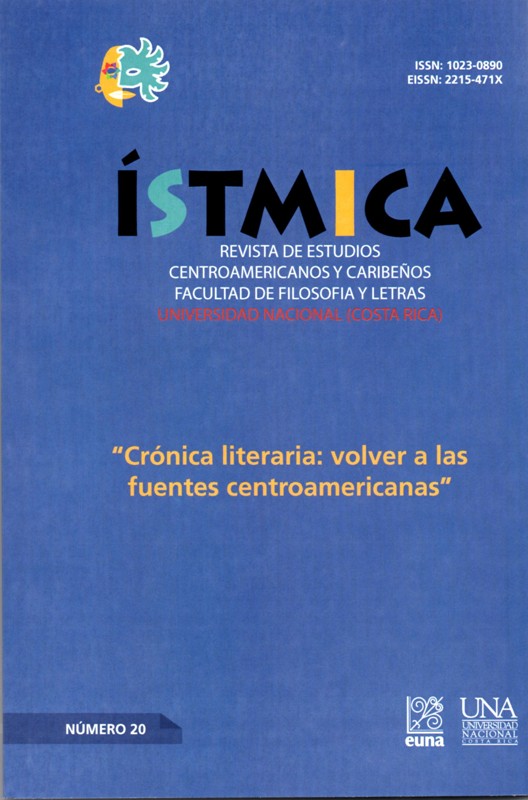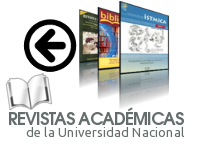Rubén Darío, lo fantástico y la Revolución Mexicana
DOI:
https://doi.org/10.15359/istmica.20.4Keywords:
Rubén Darío (1867-1916), the fantastic, Huitzilopoxtli, Mexican Revolution.Abstract
In the last years of his life, the Nicaraguan poet Rubén Darío returned to the fantastic short story because the genre offered the best narrative expression of the confusion and doubt in which he was living. In September 1910 Darío made his only visit to Mexico, which at the time was just at the beginning of the great Revolution that would overthrow the thirty-four-year-old dictatorship of Porfirio Díaz. The experience of being in the midst of a great social upheaval, as an invited guest of honor that, nevertheless, was not permitted to visit the capital, was probably an inspiration for his penultimate short story, “Huitzilopoxtli: Mexican Legend” (1977a).References
Anderson Imbert, E. (1967). La originalidad de Rubén Darío. Buenos Aires: Centro Editor de América Latina.
Anderson Imbert, E. (1993). Historia de la literatura hispanoamericana (Tomos I y II). México, D.F: Fondo de Cultura Económica.
Caillois, R., (ed.) (1967). Antología del cuento fantástico. Buenos Aires: Editorial Sudamérica, 1967.
Clendinnen, I. (1991). Aztecs: An Interpretation. New York: Cambridge University Press.
Darío, R. (1918). Autobiografía, Madrid: Mundo Latino.
Darío, R. “Diario, 1910” (1950). Obras completas, tomo I: Crítica y ensayo. Madrid: Afrodisio Aguado.
Darío, R. (1963). Cartas de Rubén Darío. Epistolario inédito del poeta con sus amigos españoles. Dictino Álvarez Hernández (ed.). Madrid: Taurus.
Darío, R. (1977a). “Huitzilopoxtli: leyenda mexicana”. Cuentos fantásticos. Madrid: Alianza. Pp. 81-87.
Darío, R. (1977b). “Edgar Poe y los sueños.” Cuentos fantásticos. Madrid: Alianza. Pp. 91-112.
Darío, R. (1996). Cuentos completos. México, D.F: Fondo de Cultura Económica.
Darío, R. (2002). Cartas desconocidas de Rubén Darío, 1882-1916. José Jirón Terán y Jorge Eduardo Arellano (eds.). Managua: Fundación VIDA.
Darsey, J. (1997). The Prophetic Tradition and Radical Rhetoric in America. New York: New York University Press.
Franco, J. (2004). “The Return of Coatlicue: Mexican Nationalism and the Aztec Past.” Journal of Latin American Cultural Studies 13.2. Pp. 205-219.
Knight, A. (1990). The Mexican Revolution (Vol. I & II). Lincoln, NE: University of Nebraska Press.
König, I. (1984). La formación de la narrativa fantástica hispanoamericana en la época moderna. New York: Verlag Peter Lang.
Lida, R. (1967). “Los cuentos de Rubén Darío.” Diez estudios sobre Rubén Darío. Santiago de Chile: Zig-Zag. Pp. 155-207.
Marrero, C. (1975). 40 lecciones de historia de la lengua española. Madrid: Playor. Pp. 142-145.
Martínez, J. M. (1997). “Introducción.” Cuentos. José María Martínez (ed.). Madrid: Cátedra. Pp. 7-66.
Miller, M. E. (1996). The Art of Mesoamerica, from Olmec to Aztec. London: Thames and Hudson, Ltd.
Navarro, T. (1968). Studies in Spanish Phonology. (Traducido por Richard D. Abraham). Coral Gables, FL: University of Miami Press. Pp. 124-139.
Pohl, J. M. D. & Lyons, C. L. (2012). The Aztec Pantheon and the Art of Empire. Los Angeles: J. Paul Getty Museum.
Rama, Á. (1973). “Sueños, espíritus, ideología y arte del diálogo modernista con Europa” (Prólogo). El mundo de los sueños. Barcelona: Industrias Gráficas M. Pareja, Barcelona. Pp. 5-61.
Todorov, T. (2001a). “Definición de lo fantástico.” Teorías de lo fantástico. (Editado y traducido por David Roas). Madrid: Arco/Libros. Pp. 47-64.
Todorov, T. (2001b). “Lo extraño y lo maravilloso.” Teorías de lo fantástico.
(Editado y traducido por David Roas). Madrid: Arco/Libros. Pp. 65-81.
Torres Bodet, J. (1966). Rubén Darío. Abismo y cima. México, D.F.: Fondo de Cultura Económica.
Williamson, E. (2009). The Penguin History of Latin America. New York: Penguin.
Downloads
Published
How to Cite
Issue
Section
License
Las personas autoras que publiquen en esta revista permiten cesión gratuita, exclusiva, de ámbito mundial de sus derechos de autoría a la Universidad Nacional (Costa Rica), conservando únicamente sus derechos morales sobre la obra publicada.
Los artículos pueden ser citados y copiados, citando a la persona autora y la fuente. Todos los artículos publicados en la Revista Ístmica están protegidos bajo una Licencia Creative Commons Atribución-NoComercial-CompartirIgual 4.0 Internacional








